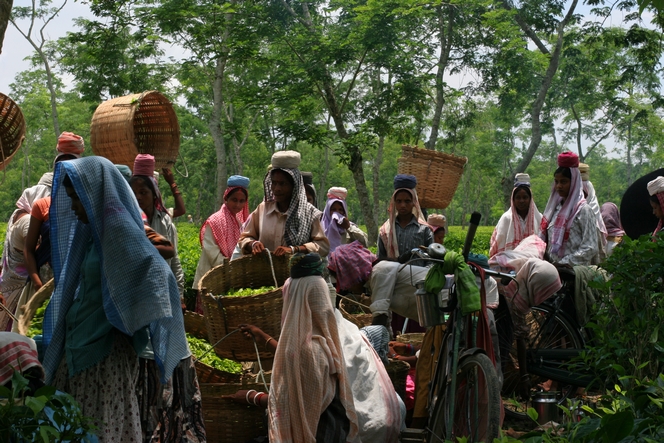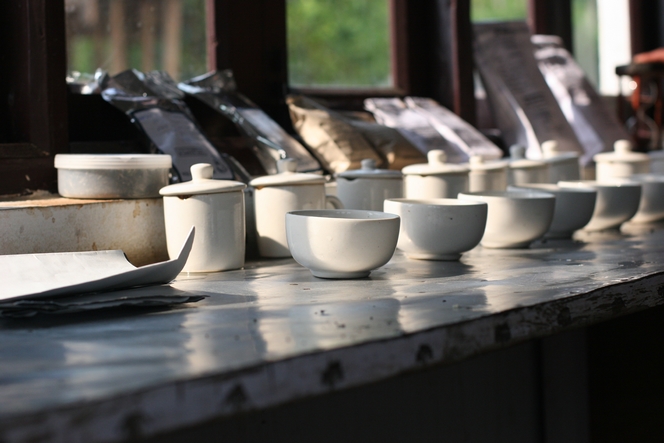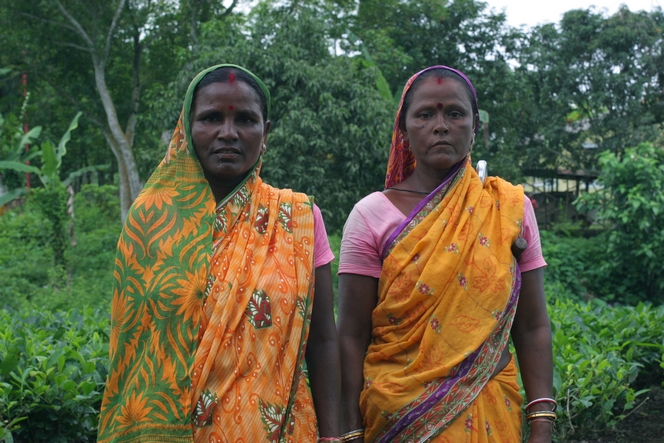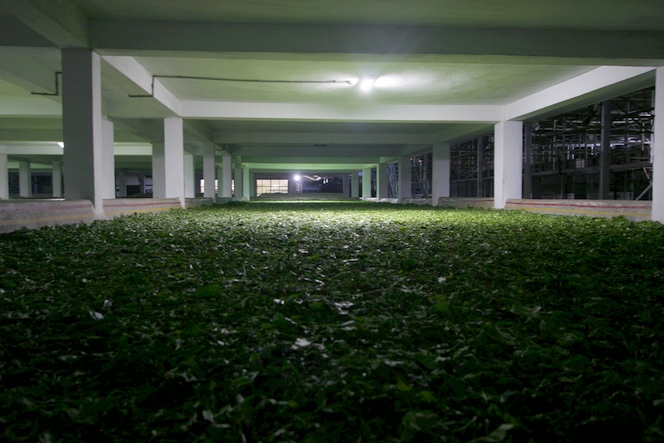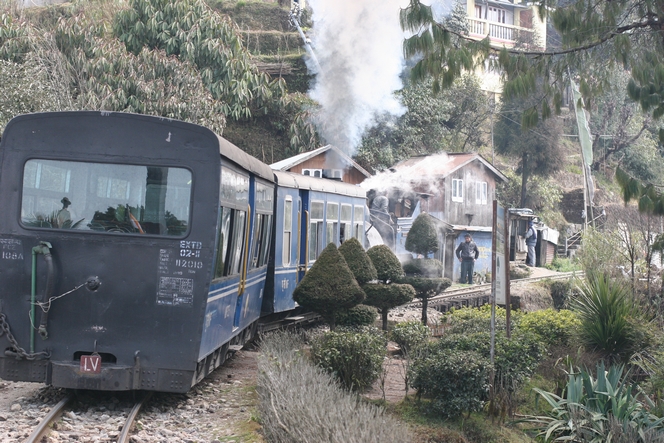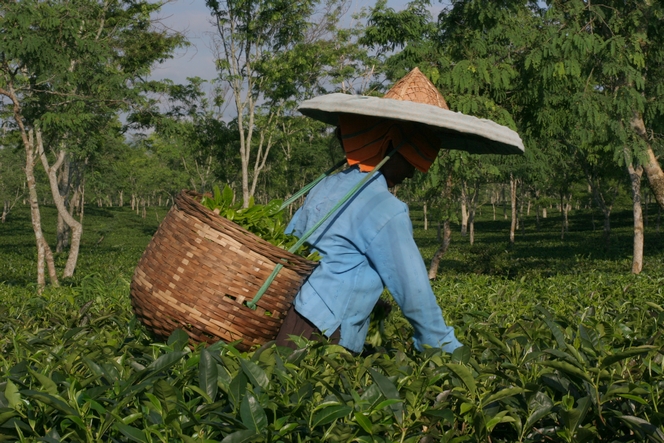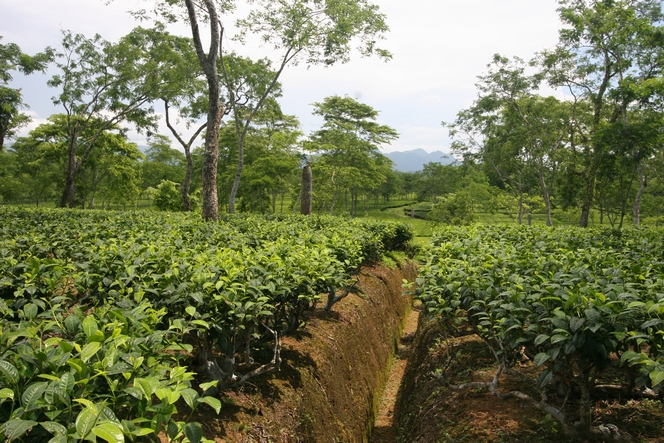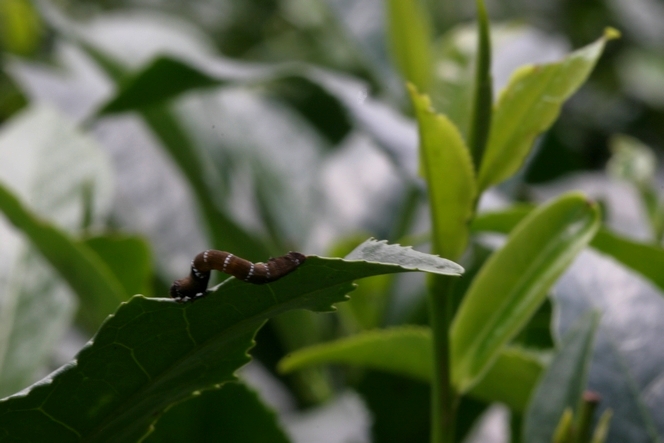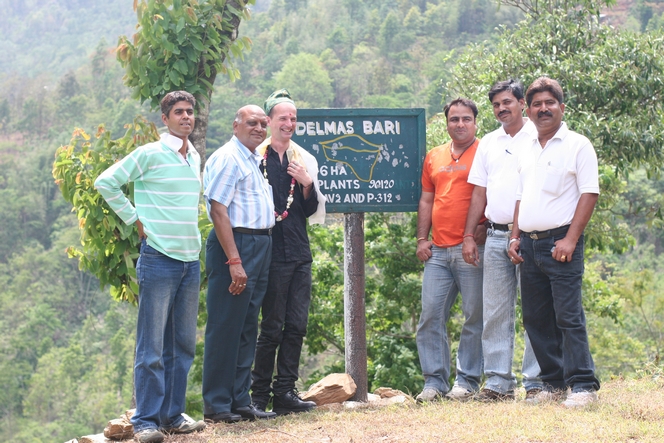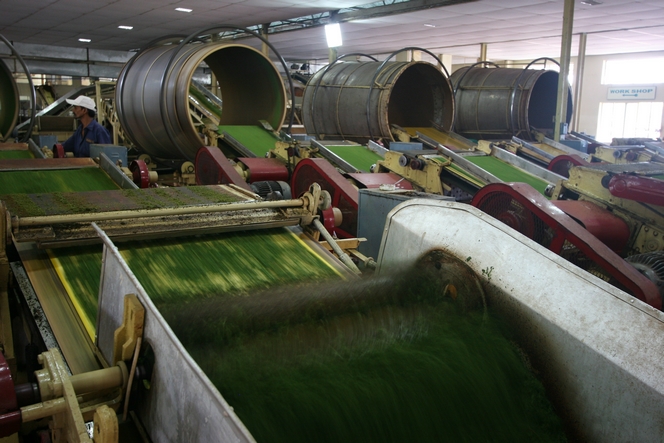In Assam, as soon as harvesting is finished, the pluckers assemble, men on one side, women on the other, and they set off with their precious baskets to the place where they will be weighed. Some women hold their baskets under their arms, but most rest them on their heads. A rolled-up piece of cloth placed precisely on the crown of the head serves to support the basket. These splendidly colourful fabrics look like crowns, making their wearers look like queens, I think.
India
Tasting rooms have windows to let in the sunlight
When tasting tea, it is good to have a source of natural light in which to judge the leaves and the infusion, as well as the liquor. It means you can assess the tea not just on its taste and aroma, but also on its appearance.
This is why, on most plantations, the tasting room has windows right down one side, to let in the sunlight. The cups of tea are placed along the windows, and while the tea is infusing, I can spread the dry leaves on a card in order to get a good look at them and judge the quality of the plucking. Or, while waiting for the timer to tell me when the infusion is ready, I can take my camera, as I did here in Darjeeling, and find the best angle to immortalise this beautiful morning light.
In Assam, there is a hierarchy in tea harvesting
There is quite a hierarchy among the people in charge of harvesting tea in Assam. This is true on the large plantations, anyway; there are also independent plots owned by small producers.
On the large plantations, the manager supervises the assistant managers, who organise the babus, whose role is to oversee the work of the sardars, who themselves are responsible for supervising the team of workers.
In this photo taken on the Dufflating plantation you can admire two sardars, who don’t look particularly approachable on first glance. But perhaps they are just reflecting, in their serious expressions, the position of authority they hold.
Tea leaves spread out as far as the eye can see
In Assam, anything related to tea processing takes place on a massive scale, because of the incredible yield they get here: four times higher than in Darjeeling. The plantations themselves cover a much larger area than elsewhere in the country.
Take the withering, for example. Instead of troughs 10 to 15 metres wide, which I am used to seeing in other parts of India, here the leaves are spread out as far as the eye can see. I took this photo at night, and the dim light adds to the mystery of this essential stage in tea processing. During the withering, the leaf will lose much of its water content (up to 40% for Assams; up to 70% for Darjeelings).
Toy Train taking a break for the delight of tourists
The little Darjeeling train sometimes takes a break. Near Ghoom, at the Batasia loop, there is a special stop which the tourists enjoy.
It is a spectacular configuration, where the track turns back on itself, climbing at the same time, before the train crosses a bridge right above the track it was on just a few minutes earlier.
In this photo the train has just completed the loop and is passing in front of some pretty and very neatly trimmed trees, a sign of the locals’ pride in their Toy Train.
Plucking tea with 35°C and 100% humidity
When you know what the climate is like here in Assam, you realise this woman must be brave to work outside. Throughout my stay in the Jorhat region, the temperature varied between 35° and 38°C, while the humidity came close to 100%.
Whatever the temperature, she rarely removes her wide-brimmed hat: it protects her from the powerful rays of the sun and also from the frequent and torrential downpours that can come at a moment’s notice.
Drains dug into the soil to protect tea plants
The tea plant enjoys humidity, but it hates having water sitting around its roots. How awkward! To keep its feet dry when the ground is flat, like here in Assam, drains are dug into the soil.
Switching locations from the plains to the peaks, I want to tell you about the mountain blocking my view right now. It marks the start of Nagaland, the sparsely populated region that borders Assam. The Nagas are a friendly people, but due to one of their ancient customs, thankfully now abandoned, they are sometimes known as “Head Cutters”.
The inchworm is an enemy of the tea plant
Among the enemies of the tea plant, the inchworm features in prime position. With a ferocious appetite, it can munch its way through quite a few leaves in a short space of time. Getting rid of them isn’t easy, especially on organic plantations. Birds are the principle predators of this creature, whose name derives from its strange gait: it advances by taking calculated “steps”, measuring out each one with apparent expertise.
“Delmas Bari” : a tea plantation named after me
One day, when I was in Darjeeling, I was surprised to find that a plot on the North Tukvar plantation had been named after me. It was a new plot, mainly planted with the AV2 cultivar which I am particularly fond of.
This gesture from G. Somani, superintendant of North Tukvar and Puttabong, touched me greatly, and from time to time I return to “Delmas Bari”. The tea plants have grown, they look magnificent at the moment. The place has a unique charm about it. A small stand provides shade where you can enjoy a cup of tea and take in the incredible beauty and utter tranquillity of the surroundings. I feel quite at home there!
Machines used in the tea bag industry
Assam tea plantations are unusual in that they produce “orthodox” tea, processed according to the traditional method, but they also produce “CTC” tea, which stands for “cut, turn, curl”. CTC tea has none of the qualities of a fine tea. It is produced by machines, which I have photographed for you. This tea doesn’t interest me much, and for good reason: one of its uses in the tea bag industry is to bring colour quickly to the cup and express strength.
Nonetheless, the process of making CTC tea is interesting: as it passes through the various machines, the leaf gradually gets smaller and smaller until it is just a tiny round ball.

